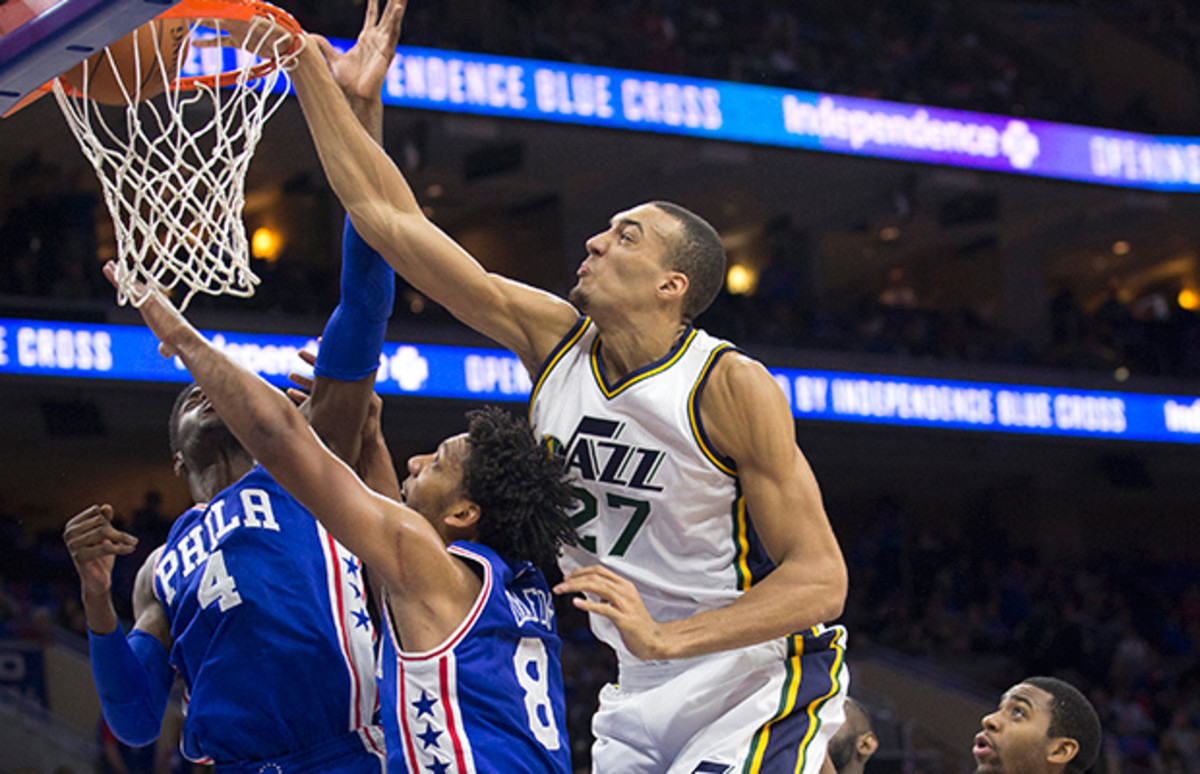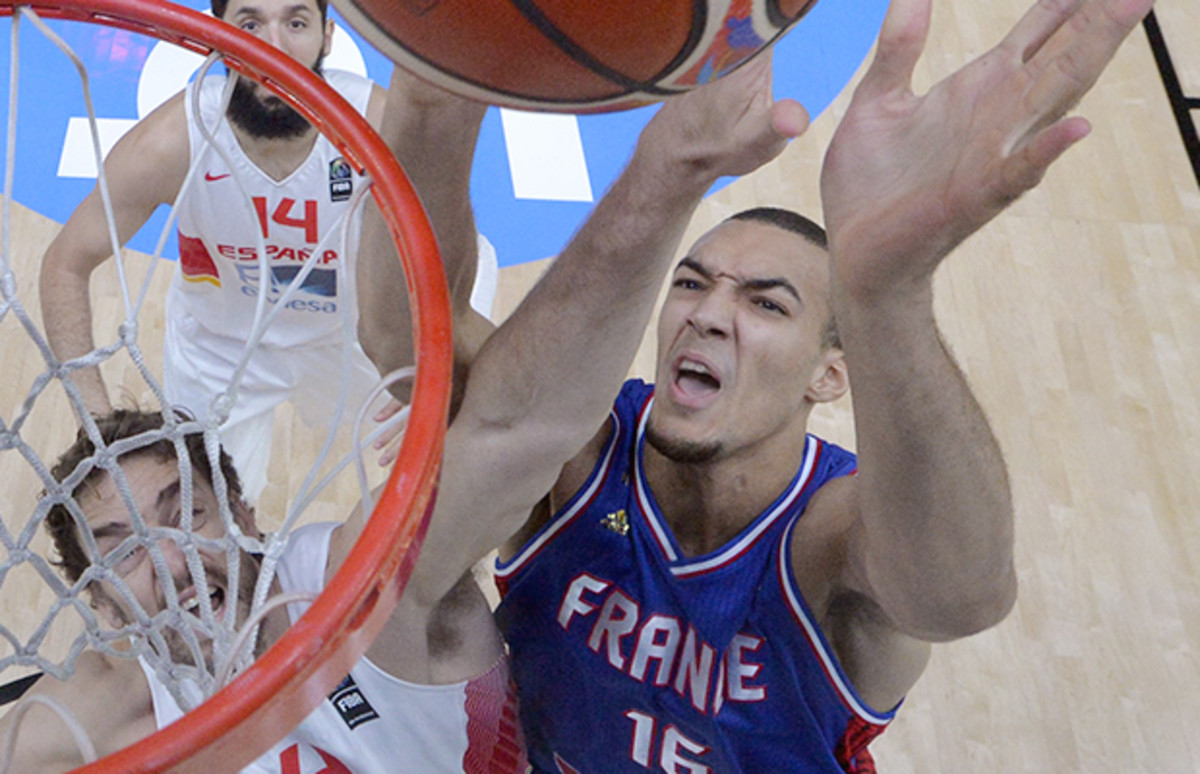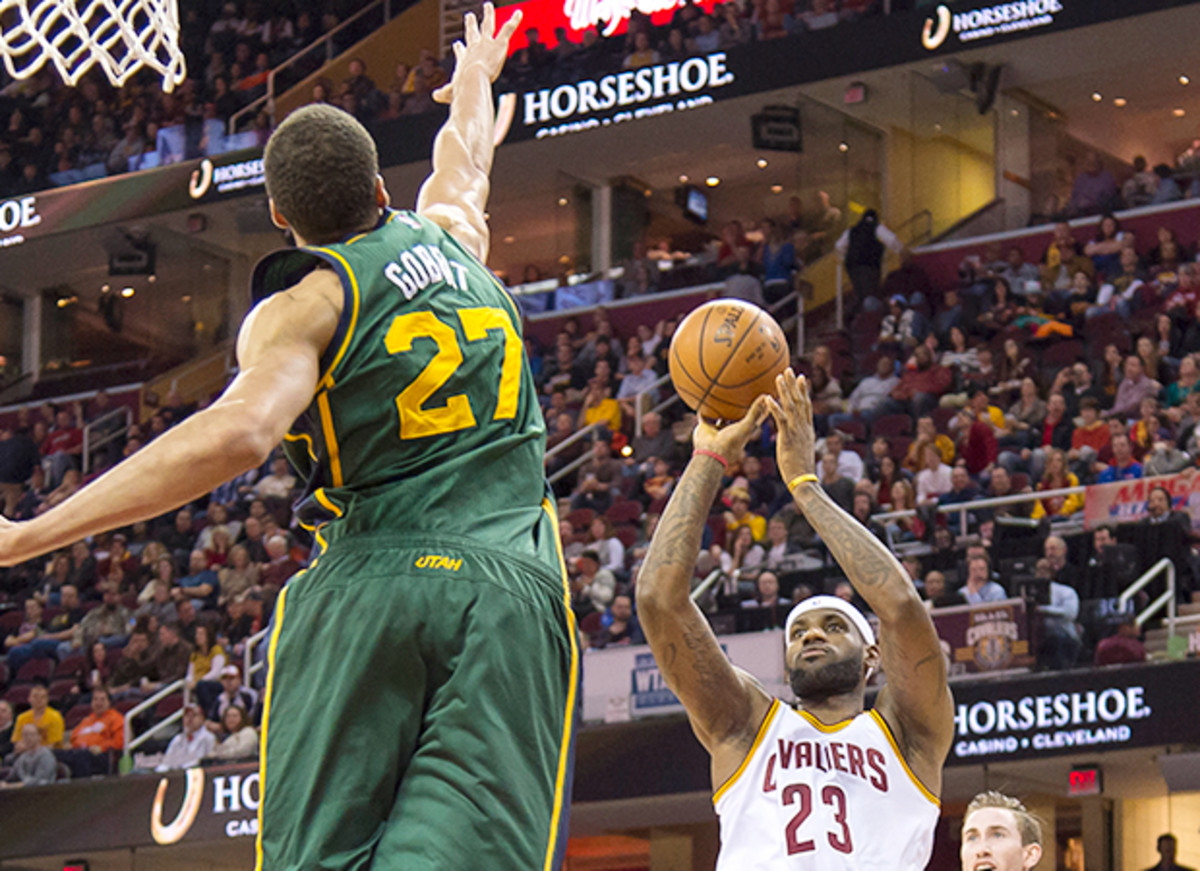Standing tall: Rudy Gobert altering shots, perceptions of French players

For many, the words French basketball bring only one image to mind: a lethargic, earthbound big man cowering as Vince Carter leaps over him to complete a thunderous, reputation-ossifying jam. But the perception created by that historic dunk—which came, of course, against the infamous Knicks draft bust Frédéric Weis in the 2000 Olympics in Sydney—is entirely outdated. The French can ball now.
It’s not just Tony Parker. This season NBA rosters feature 11 Frenchmen. Eight of them average more than 18 minutes, including shooting guard Nicolas Batum, the Hornets’ second-leading scorer; Ian Mahinmi, the regular center for the Pacers; and Evan Fournier, who started 41 of the Magic’s first 42 games at shooting guard. The Gallic influence on the league is so pervasive that its French speakers often find that they can no longer use their native tongue to communicate strategy to one another, like Navajo code talkers.
Last season, as if out of nowhere, a new French star emerged as a singular force, not just compared with the rest of his growing legion of countrymen but compared with the entire NBA. When the Jazz traded for the then-21-year-old Rudy Gobert, who had just been picked 27th by the Nuggets, in a draft-night deal in 2013, they thought that his physical attributes—his lithe, 7'1" frame, his NBA-combine-record 7'8½" wingspan—might one day add up to something useful.
After a rookie year that Gobert spent mostly folded up on the bench—that is, when he wasn’t dispatched to the NBDL’s Bakersfield (Calif.) Jam—Utah coach Quin Snyder began giving the Frenchman meaningful minutes. It wasn’t long before he couldn’t stop. Gobert finished fifth in the voting for defensive player of the year in 2014–15, even though he started just 37 games. He also acquired a rabid, nickname-bestowing fan base. While he prefers Gob-zilla to the French Rejection and the outdated Gobert Report, the Stifle Tower seems to be the sobriquet that will stick.
• GOLLIVER: Jazz’s Rodney Hood outshining heralded peers of ’14 draft class
There are many ways to quantify Gobert’s impact, but the most illuminating is to look at the performance of the Jazz with and without him. Gobert became Utah’s starting center in February 2015, after the team tradedEnes Kanter to Oklahoma City, but had to relinquish the role for a month this season because of a sprained left knee. In Gobert’s 59 career starts through Sunday, the Jazz were 34–25 and have allowed 92.2 points per game. In the other 66 games they are 23–43 and have given up an average of 99.0 points. In other words Gobert’s presence in the paint means the difference between a hopeless also-ran and a playoff team whose defense is rivaled by only the Spurs’. At week’s end Utah, having scuffled through Gobert’s injury, was 19–24 and one game out of the final postseason berth in the Western Conference. It is not a stretch to suggest that Gobert is one of the most pivotal players in the NBA.

Gobert’s size certainly factors into his dominance—he can touch the backboard more than 27 inches above the rim—but many 7-foot behemoths walk the earth, including Weis. As a boy Gobert used to watch a YouTube video of Carter’s dunk, over and over. “Nobody will ever do that to me,” he would say to himself, observing how Weis backed down. “Ever.” What really separates Gobert from scores of other big men who have preceded him is the same thing that turned him from lanky project to nightly enforcer in what seemed like the blink of an eye, and it's not his rapidly improved strength, timing or ability to avoid fouls. It’s that he cares, deeply and often to the point of anger. He views each opponent who slashes into his lane as a personal affront. “Some guys don’t have pride,” he says. “I do. Sometimes too much.”
Gobert is doing his part to upend shopworn ideas about passive, surrendering Frenchmen. “He gets pissed, which I like,” says Snyder. “Whatever kind of stereotypes Americans have about the French, they don’t apply.”
Where did this ferocity come from? It started in a city some Parisians haughtily describe as the Milwaukee of France, the Cleveland of France and the What Is Worse Than Cleveland? of France.
***
Saint-Quentin pop. 56,000), an hour and 40 minutes northeast of Paris by train, is large enough to qualify as a city, but small enough that the mayor makes a habit of approaching visitors, thrusting out his hand and announcing, “I am the mayor.”
On a visit to Saint-Quentin last July, a few things were strange. There were very few people in the streets. The lone open business was, not counting a vending machine that sold only eggs, a horse racing betting parlor. And every few minutes the quiet was interrupted by sharp explosions.
It was July 14—Bastille Day. The explosions were the result of firecrackers schoolboys were throwing into empty bins, before scurrying away with their fingers plugging their ears. As Gobert piloted a loaned Citroën Picasso around familiarly winding streets, American hip-hop blasting, he scanned storefronts for an open fireworks shop. Though he was mostly in town to oversee the inaugural Rudy Gobert Basketball Camp, for which 72 young players had signed up, he still wanted to ignite a few bottle rockets. His passenger mentioned that just 10 days before Giants pass rusher Jason Pierre-Paul had lost a finger, as well as a $60 million contract offer, while setting off fireworks. “Don’t worry, I don’t like the big ones,” Gobert said. “I’ll just do a couple.”
• JENKINS: Kristaps Porzingis silencing doubters and taking over New York
Unlike many extremely large people, Gobert always seems perfectly at ease with himself and his place in the world. He reclined comfortably in the Citroën’s small cabin and deftly manipulated its weird plastic gear-shift. He speaks English well and with confidence, his accent thickening only sporadically, such as when he is discussing the animals he enjoys watching at the zoo back in Salt Lake City (gor-ee-yas, ree-no-serrus). And in the cozy apartment in which his mother, Corinne, raised him before he left at 15 to play for a pro club in Cholet, he easily dipped under doorways that still bear the pencil marks the two used to track his growth—until he was taller than the sill. “When you hit your head on the door a couple of times, you get used to ducking,” he says.
Corinne is a retired cosmetologist, with carefully coiffed blonde hair and lacquered blue fingernails. Rudy wasn’t always so sure of himself, she says. He was an excellent student but would get into fights at school, despite Corinne’s efforts to help him channel his aggression into sports: track and field, boxing, karate, even Ping-Pong. He was drawn to basketball but had little control over his body, which when he was a young teenager wasn't extraordinarily big. He grew seven inches between ages 15 and 18, and it took him time to adjust. “He could not stand on his legs,” says Philippe Urie, a longtime coach in the French national system. “He could not grab the ball. It was a very tough time for him.”
“He was a guard, could not really handle the ball, could not really shoot,” says his friend Fournier. “He was not that good, to be honest.”

Even when he was a 15-year-old guard who was passed over for a place at INSEP, France’s national sports academy, Gobert believed that he was destined to be not just a big man but also a dominant one. That’s what his father had strived to be. Rudy Bourgarel was born on Guadeloupe, grew to 7 feet and was the backup center in the mid-1980s to 7'4" Rik Smits at Marist College in Poughkeepsie, N.Y. A few years later his own NBA dreams dashed, Bourgarel found himself playing professionally for Saint-Quentin’s periodically successful France Pro-B team. That’s when he met Corinne, then a divorced mother of two. Gobert was born in ’92, but by the time he was three, his parents had split up. His father eventually moved back to Guadeloupe, 4,000 miles away.
Though Gobert can now afford to visit his dad annually, as a child he could do so only about once every three years. He and Corinne maintain the close, affectionately teasing relationship of what was a two-person unit for many years (his half-siblings are nine and 17 years older), but he says his basketball drive and aggressiveness comes from his father—or, more specifically, from his father’s absence. “Even if he wasn’t there much of the time to teach me stuff, I think I was trying to be a basketball player too, like him,” Gobert says.
While Gobert is refashioning the image of French hoops, it is too much to imagine that the specific alchemy that created him might be repeated. “People are gonna think that everybody is going to be like me—and they’ll be disappointed, next time,” he says in his mother’s red-lit living room. “Everybody is different.”
“Oui, mon cheri,” says Corinne. “There is only one like you.”
***
Late on the night of Jan. 22, 2015, the NBA’s Twitter account received an unusual direct message. "I don't like to complain about stats but my blocks are very important to me," the message read. "I had 2 clean blocks in the first quarter. And they only counted me 1 please take a look one on ilyasova and one on zaza pachulia. Thanks!"
The sender was Rudy Gobert. His protest was in vain.“I was very mad,” he says. “To be honest, I was trying to pass Anthony Davis in blocks, but then he started blocking like nine shots a night and got too far away from me anyway." Gobert would finish the season with 189 blocks—11 shy of Davis—for an average of 2.30 per game.
Gobert takes rejection seriously. Dan Clayton, a blogger for SaltCityHoops.com, maintains a running list of all of the players Gobert has blocked. Last week the tally reached 190, representing more than 40% of the league. Gobert claims that he can tell you whether or not he has denied a particular player if you give him a name, and for the most part he can.
LeBron James? “Yes. I did. The next game he skyhooked me.”
Andre Drummond? “I would have, but they called a charge.”
James Harden? “I blocked him. Blocked the s--- out of him.”
Russell Westbrook? “That’s the guy I have the most blocks against! He doesn’t care. He’ll just keep coming at you.”
Gobert also remembers the instances in which his block attempts were spectacularly unsuccessful—and so do many NBA fans, as those events immediately become Dunk of the Year contenders, the clips played ad nauseam on TV and on social media. One came on March 30, 2015, when 6'8" Timberwolves guard Andrew Wiggins soared above him for a one-handed slam. Another came two months ago, when the 6'7" Raptors guard DeMar DeRozandid the same.
• JENKINS: From project to pillar: Drummond becomes a Pistons cornerstone
What the endlessly looped highlights don't show is what happened later in those games: how Gobert rejected Wiggins on his next dunk attempt in a 20-point Jazz romp and how he forced DeRozan into throwing up an air ball in the late stages of a four-point victory.
“I tell him that I hope there’s a poster of someone dunking on you in every city in the NBA,” says Snyder. “Because it means he’s there. If getting dunked on every now and then is the cost? Net-net, it’s going to work out in his favor.”
While he does like his blocks—not to mention his points (9.2 per game through Sunday on 57.8% shooting) and rebounds (10.1)—Gobert’s commitment to defense extends beyond a desire to pin new pelts to his wall. He knows that his true impact stems not from the handful of rejections he gets each night but from what he does on all the other possessions. “If you play good defense, most of the time you don't get a block because it doesn’t even come to this point,” he says. “They don’t even come inside, or they throw a high floater or something.”

He is, in a sense, like a shutdown cornerback, who might get a few interceptions but who is far more disruptive to offenses by rendering off-limits a great swath of the field—or, in Gobert’s case, the paint. “I think it’s a really good analogy,” says Snyder. “Players may be going to the rim, but they're more conscious of making adjustments to his length. That means taking harder shots.”
When opponents do challenge Gobert inside, it generally doesn’t turn out well. The NBA’s new player-tracking technology reveals that those who take shots at the rim against Gobert were making just 40.3% of them at week’s end, the best rate for any defender who is averaging at least 18 minutes. While Gobert ranks second to Heat center Hassan Whiteside in blocks by a significant margin—3.85 to 2.65 per game—Whiteside is allowing opponents to shoot 47.6% at the rim, suggesting that he sells out for rejections more than he should. “Um, I think obviously he}s good at blocking shots, for sure, but defense is not only blocking shots,” says Gobert.
“When somebody gets beat or we channel some-body to the baseline, give them a drive to the rim, we know Rudy’s there," says Jazz swingman Gordon Hayward. “And if he doesn’t block it he’s going to alter it or make them make an extra pass.” It is not just Gobert’s size and shot blocking that transforms the Jazz when he is on the court, but his relentlessness—his passion.
***
Gobert had a busy summer. In early September he played in the 24-nation EuroBasket tournament. For France the competition would end in the semifinals with an 80–75 overtime loss to Spain, a game in which the Bulls’ Pau Gasol was awarded 18 free throw attempts. Gobert called it the worst defeat of his life, mostly for competitive reasons but partly because of what he knew it represented to some of France’s anti-immigrant factions. French basketball mirrors the country’s multicultural present—almost all the national team members trace their lineages to France’s current or former territories in Africa and the Caribbean—and he puts at least some stock in the sport’s power to soothe simmering ethnic tensions in the country. “For some, it’s always the same,” he says. “When we lose, we’re not really French. And when we win, we’re French.”
First, though, he had his weeklong camp at a school in Saint-Quentin. The 72 campers represented a mix of races, and they tended to favor T-shirts with mysterious English phrases printed on them: UNIVERSITY OF CLEVELAND FIRST ATHLETIC TEAM, and BAD.
• MAHONEY: The Craft: Derrick Favors adapts to new world of NBA big men
When it began to get dark on Bastille Day, most of the kids left the gym to watch the fireworks. Gobert never bought any, and now it was too late. Soon there were only two campers left, neither of whom cleared Gobert’s belly button. A half-court game of two-on-one began.
“If I play a game, even a pickup game, maybe at first I’m going to be like, ‘O.K., I don’t care,’” Gobert says. “But at the end I don’t want to lose, and I end up playing hard.” At first Gobert was just messing around, tossing up threes and playing soft defense. Then it happened. One boy, with Gobert towering over him, sprang backward and flung a from-the-hip jumper, almost straight up, that just scraped Gobert’s fingers. It descended through the net, to the astonishment of both parties.
Gobert nodded at the boy and grimaced. On the next possession he blew past both boys and slammed home a reverse jam that reverberated louder than any of the fireworks outside.
The boys hugged each other with glee. Gobert grinned. “I couldn’t leave,” he says, “on a loss.”
